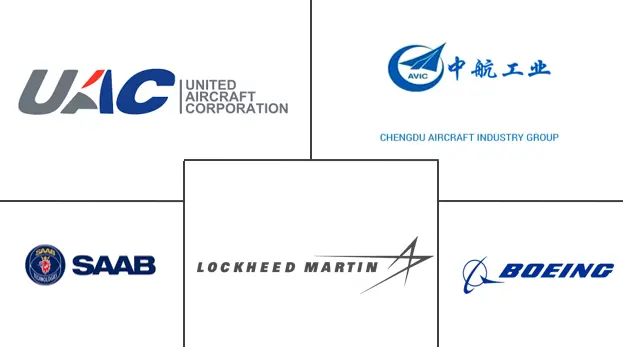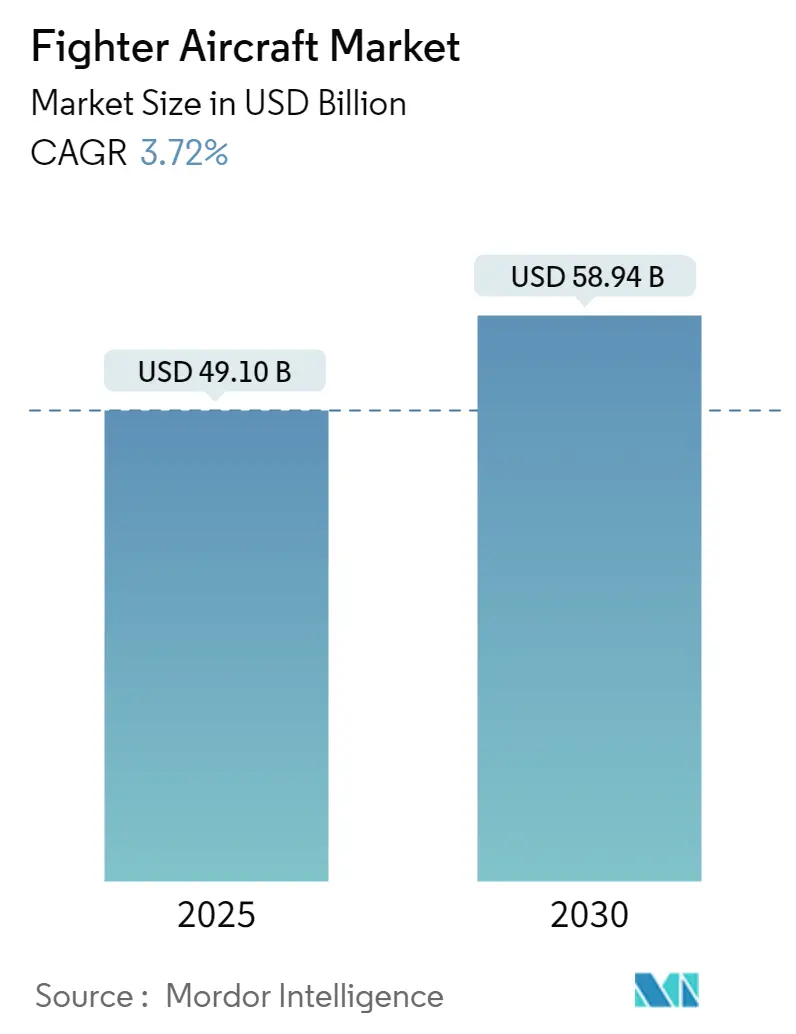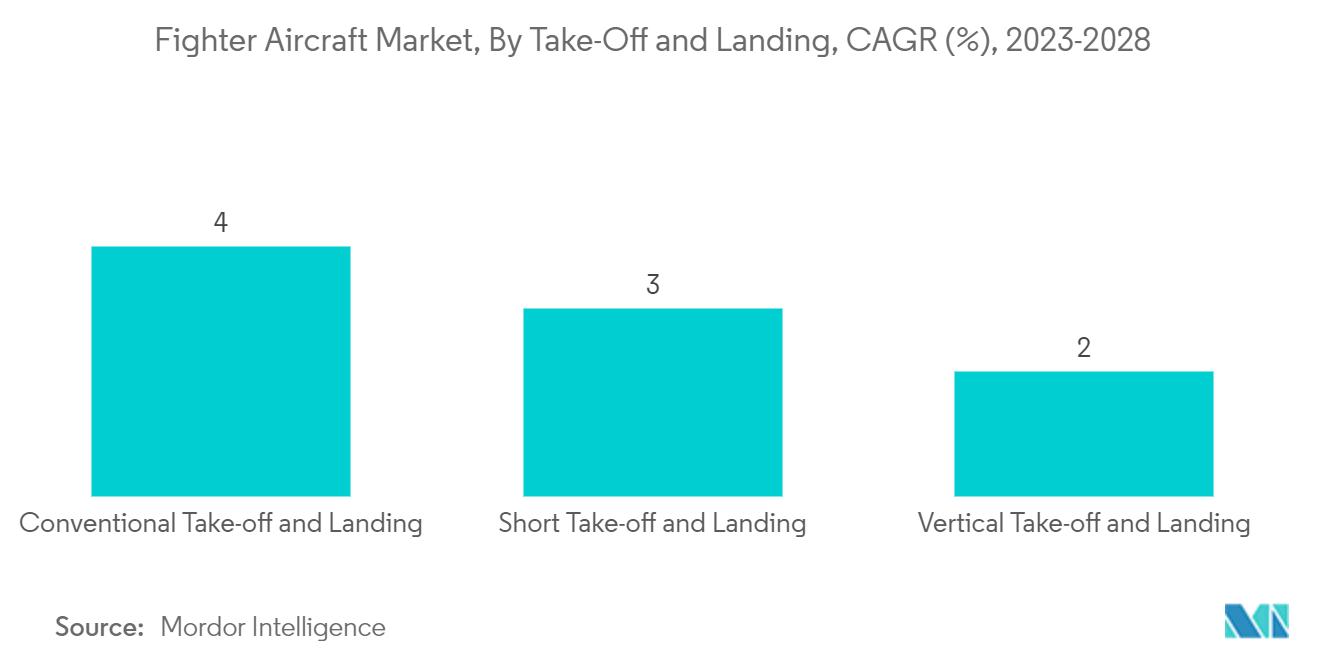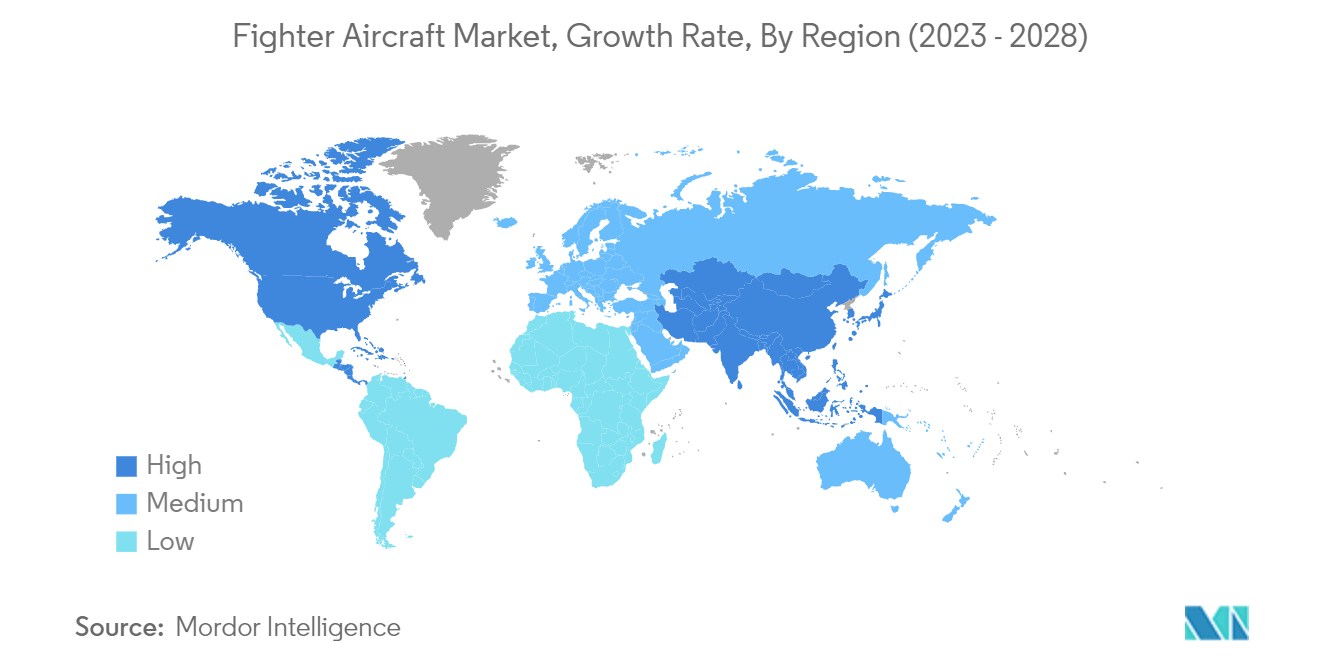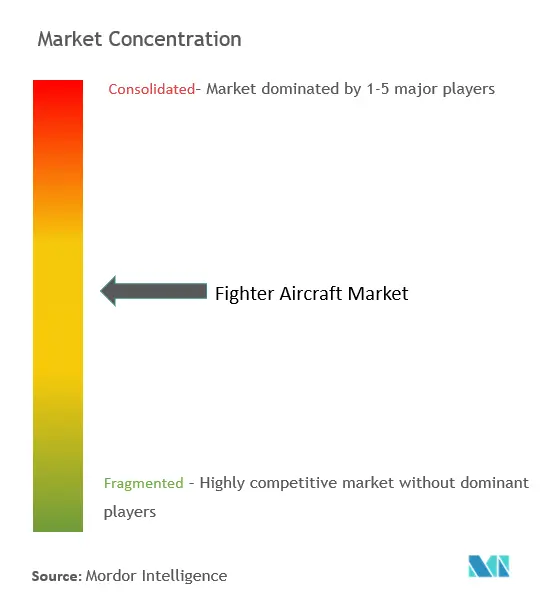Fighter Aircraft Market Analysis
The Fighter Aircraft Market size is estimated at USD 49.10 billion in 2025, and is expected to reach USD 58.94 billion by 2030, at a CAGR of 3.72% during the forecast period (2025-2030).
- The COVID-19 pandemic negatively impacted the fighter aircraft market, affecting delivery and production. Stringent regulations aimed at reducing the spread of the virus caused delays in the delivery of fighter aircraft to various countries. Furthermore, the pandemic led to layoffs in various companies, hampering the production process. However, with the decline in the pandemic, the market witnessed growth due to the ease in restrictions and increased production and delivery of fighter aircraft worldwide.
- The growing geopolitical tensions between nations have prompted the adoption of advanced fighter aircraft to modernize existing fleets and enhance their aerial defense capabilities. Advancements in technology, such as stealth and precision weapons, are further supporting the development of the fighter aircraft market as nations strive to keep their combat capabilities up-to-date.
- However, budget constraints may hinder market growth, particularly for developing countries that may opt for upgrading existing old fighters to cut costs rather than investing in next-generation fighter jets.
Fighter Aircraft Market Trends
By Take-Off and Landing Segmentation, the Conventional Take-Off and Landing is Expected to Witness Significant Growth During the Forecast Period
- The conventional take-off and landing segment is expected to experience significant growth during the forecast period due to its ability to carry a higher payload capacity for weapons and equipment, as well as its greater battle range. This growth is anticipated to be fueled by the development of new fighter aircraft programs such as China's J-20, Su-37, Mig-35, Su57, and India's TejasMK2, which will replace aging fourth-generation fighter aircraft with 4.5th, 5th, and 6th generation aircraft.
- Additionally, countries are engaging in modernization programs such as the F-16, F-15, and F/A-18 to improve aircraft capabilities and life extension. Some prominent countries across the globe are also planning or have started procuring new fighter aircraft to address concerns about their aging military fleets.
- For example, in April 2022, the Brazilian air force ordered four Saab-Embraer F-39E jets in addition to the 36 purchased in 2014 as part of a USD 4.7 billion contract. The country is also considering ordering another batch of at least 30 F-39E fighters with a local designation of Gripen NG aircraft.
- Furthermore, with the rapid advancement of technology, countries are striving to enhance their aerial troop support capabilities by procuring next-generation transport aircraft. As a result, they are awarding contracts to aircraft manufacturing companies. For instance, in June 2021, Airbus reportedly secured a contract with an undisclosed nation in the Asia-Pacific region for its C-295 transport aircraft. These developments are expected to contribute to a positive outlook for conventional take-off and landing aircraft during the forecast period.
The Region of North America is Expected to Witness Significant Growth During the Forecast Period
The region of North America is expected to witness significant growth during the forecast period. The United States military expenditure increased by almost 2.9% in 2021 to reach USD 801 billion from USD 778.23 billion in 2020. The United States remained the largest defense-spending country in 2021 and represented 38% of global spending.
Moreover, the United States Air Force is gradually addressing its aging aircraft problem, as it takes delivery of newer generation jets. As inventories decreased, the average aircraft age increased over the past decade. The average age of the United States Air Force fleet is over 25 years, and bombers have an average age of over 50 years. Moreover, the United States Department of Defense is awarding contracts for fighter aircraft. For instance, in July 2022, The United States Department of Defense is committed to manufacturing around 375 F-35 fighter jets over a three-year period With Lockheed Martin Corp. Additionally, according to the Pentagon, the final number of aircraft covered by this agreement could change depending on any alterations made by the United States Congress to the budget for the Fiscal Year 2023 and any orders put in by foreign partners.
Apart from the fixed-wing transport aircraft, the United States armed forces are also modernizing its fleet of utility helicopters. The United States Navy plans to retire all its C-2 aircraft by 2024, as it has started taking deliveries of CMV-22B Osprey. Both the United States Navy and Marine Corps have placed orders for Ospreys in the past few years. Moreover, in June 2022, a contract of USD 2.27 billion has been awarded to Sikorsky Aircraft Corp., Stratford, by the United States department of defense for procurement of 120 H-60M Black Hawk helicopters and associated support for the fiscal years 2022-2026, with options for an additional 135 aircraft.
Thus, such developments will lead to the fighter aircraft witnessing significant increase during the forecast period.
Fighter Aircraft Industry Overview
The aerospace and defense industry boasts several leading players, including Lockheed Martin Corporation, The Boeing Company, United Aircraft Corporation, Chengdu Aircraft Industrial (Group) Co. Ltd., and Saab AB. However, Lockheed Martin Corporation holds a prominent position in the market due to its high delivery volumes of F-35 fighter aircraft. Its ongoing research and development efforts further reinforce the company's market dominance focus on creating high-performance fighter aircraft and technologies that provide superior capabilities for engaging and neutralizing airborne, ground, and hostile naval forces.
Lockheed Martin Corporation's extensive product portfolio, featuring several variants, and continuous product development cycles, enable enhanced operating life of aerial assets. This robust research and development framework also attracts potential buyers seeking higher performance reliability and upgrade potential from their aerial assets.
Fighter Aircraft Market Leaders
-
Lockheed Martin Corporation
-
The Boeing Company
-
Saab AB
-
Chengdu Aircraft Industrial (Group) Co. Ltd
-
United Aircraft Corporation
- *Disclaimer: Major Players sorted in no particular order
Fighter Aircraft Market News
June 2022: Jordan received a letter of offer from Lockheed Martin for the sale of eight new production F-16 Block 70 aircraft. The acquisition of these advanced aircraft will further enhance Jordan's existing fleet capabilities.
November 2021: United Aircraft Corporation began production of the Sukhoi Checkmate at its Siberian facility. This single-engine 5th generation fighter jet is being developed as part of a partnership between the UAE and Russia, as per a Memorandum of Understanding (MoU) signed in 2017. The Sukhoi Checkmate was unveiled as a prototype at the MAKS 2021 and is currently on display at the Dubai Air Show 2021. This project is aimed at meeting the UAE's need for a single-engine fighter jet with advanced capabilities.
Fighter Aircraft Industry Segmentation
A fighter aircraft can be termed a high-speed fixed-wing military aircraft that can carry out air-to-air combat missions. High speed, ease of maneuvering, and relatively smaller size are the hallmarks of fighter aircraft. These aircraft can also carry heavy payloads and perform electronic warfare, ground attacks, and air-to-air combat.
The fighter aircraft market is segmented by take-off and landing, type, and geography. By take-off and landing, the market has been segmented into conventional take-off and landing, short take-off and landing, and vertical take-off and landing. By type, the market has been segmented into light attack, electronic warfare, multi-role fighter, trainers, and others. By geography, the market has been segmented into North America, Europe, Asia-Pacific, Latin America, and the Middle East and Africa.
The market sizes and forecasts are provided in terms of value (USD million) for all the above segments.
| Take-off and Landing | Conventional Take-off and Landing | ||
| Short Take-off and Landing | |||
| Vertical Take-off and Landing | |||
| Type | Light Attack | ||
| Electronic Warfare | |||
| Multi-Role Fighter | |||
| Trainers | |||
| Other Types | |||
| Geography | North America | United States | |
| Canada | |||
| Europe | Germany | ||
| United Kingdom | |||
| France | |||
| Russia | |||
| Rest of Europe | |||
| Asia-Pacific | China | ||
| India | |||
| Japan | |||
| South Korea | |||
| Rest of Asia-Pacific | |||
| Latin America | Brazil | ||
| Rest of Latin America | |||
| Middle East and Africa | United Arab Emirates | ||
| Saudi Arabia | |||
| Egypt | |||
| Rest of Middle East and Africa | |||
Fighter Aircraft Market Research FAQs
How big is the Fighter Aircraft Market?
The Fighter Aircraft Market size is expected to reach USD 49.10 billion in 2025 and grow at a CAGR of 3.72% to reach USD 58.94 billion by 2030.
What is the current Fighter Aircraft Market size?
In 2025, the Fighter Aircraft Market size is expected to reach USD 49.10 billion.
Who are the key players in Fighter Aircraft Market?
Lockheed Martin Corporation, The Boeing Company, Saab AB, Chengdu Aircraft Industrial (Group) Co. Ltd and United Aircraft Corporation are the major companies operating in the Fighter Aircraft Market.
Which is the fastest growing region in Fighter Aircraft Market?
Asia Pacific is estimated to grow at the highest CAGR over the forecast period (2025-2030).
Which region has the biggest share in Fighter Aircraft Market?
In 2025, the North America accounts for the largest market share in Fighter Aircraft Market.
What years does this Fighter Aircraft Market cover, and what was the market size in 2024?
In 2024, the Fighter Aircraft Market size was estimated at USD 47.27 billion. The report covers the Fighter Aircraft Market historical market size for years: 2020, 2021, 2022, 2023 and 2024. The report also forecasts the Fighter Aircraft Market size for years: 2025, 2026, 2027, 2028, 2029 and 2030.
Our Best Selling Reports
Fighter Aircraft Industry Report
Statistics for the 2025 Fighter Aircraft market share, size and revenue growth rate, created by Mordor Intelligence™ Industry Reports. Fighter Aircraft analysis includes a market forecast outlook for 2025 to 2030 and historical overview. Get a sample of this industry analysis as a free report PDF download.

